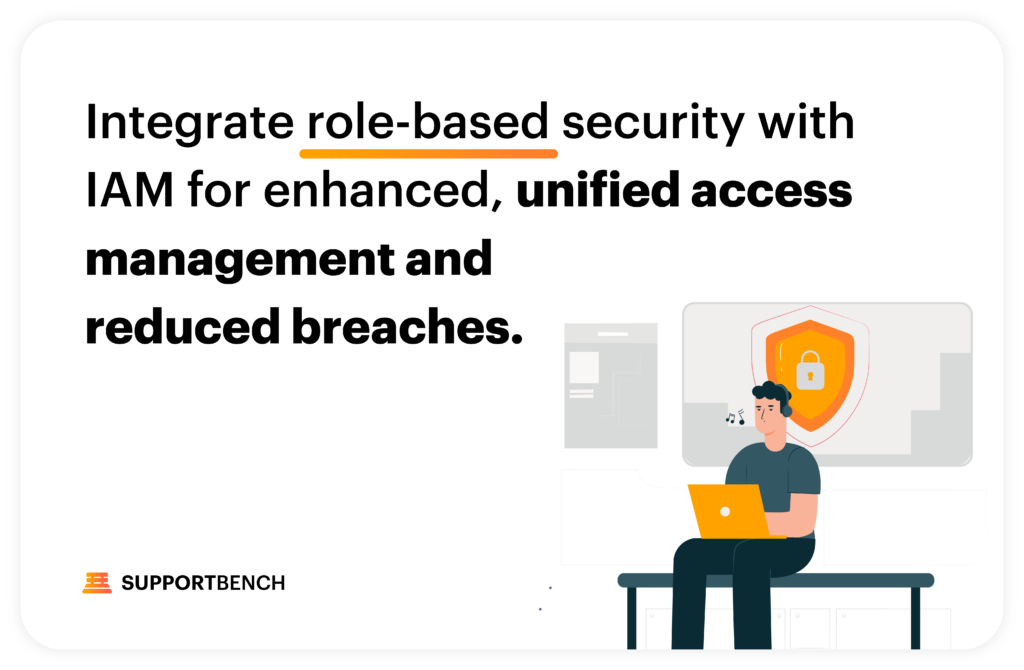The era of hyper-connectivity and increasing interdependencies in digital ecosystems has brought forth a growing need for enhanced security protocols in all business operations. This is particularly true for customer support, a crucial element in the B2B enterprise landscape. Role-based security in customer support provides a powerful method for protecting sensitive customer data and ensuring seamless operations. This article will delve into the trends, benefits, and implementation strategies related to role-based security, providing valuable insights for leaders aiming to leverage this approach to bolster their customer support operations.
The Changing Security Landscape in Customer Support

“The threat landscape has evolved, and so must our defense strategies. Data is the lifeblood of any organization, and we must protect it vigorously,” remarks Kenneth White, renowned security researcher and co-founder of the Open Crypto Audit Project.
Traditionally, customer support teams have relied on standard security measures, such as encryption, firewalls, and antivirus software. However, with advancements in technology and the growing sophistication of cyber threats, these methods are no longer sufficient. Role-based security represents a more robust, flexible approach that is increasingly gaining traction.
The Rise of Role-Based Security
Role-based security provides a structured approach to data access. In essence, it involves assigning roles to users and granting them permissions based on their roles. The benefits are twofold: it helps to protect sensitive data and also streamlines operations by ensuring that the right people have access to the right information at the right time.
A study conducted by Ponemon Institute in 2022 revealed that companies that implemented role-based security reported a 23% decrease in data breaches compared to those that didn’t. This underscores the critical role that this approach can play in fortifying customer support operations.
Role-Based Security – What you can do today
As leaders seek to implement role-based security in their customer support operations, several trends offer valuable insights.
Risk-Based Role Assignments
Risk-based role assignments involve assigning roles and permissions based on the risk levels associated with different tasks. For instance, a task that involves handling sensitive customer data may warrant stricter roles and permissions than a task involving less sensitive data. Adopting a risk-based approach can help to mitigate potential security threats.
To implement this trend, enterprises can conduct regular risk assessments to identify high-risk tasks. Once these tasks have been identified, appropriate roles can be assigned to help mitigate the associated risks. This ensures a more secure and efficient operation.
Dynamic Role Adjustments
The concept of dynamic role adjustments takes the role-based security approach a step further. Rather than having fixed roles, permissions are dynamically adjusted based on a user’s current task or context. This provides greater flexibility and ensures that data access is as restrictive as necessary without hindering productivity.
To put this trend into action, enterprises could leverage advanced technologies like AI and machine learning. These technologies can help to automatically determine the context and adjust roles and permissions accordingly.
Attribute-Based Access Control (ABAC)
ABAC is a more sophisticated evolution of role-based access control. It uses a variety of attributes, including user role, environment, time, and task, to make access decisions. ABAC provides a more granular level of control, making it possible to implement complex access rules.
Implementing ABAC requires robust policy management capabilities. Businesses need to carefully define their access policies based on various attributes and ensure that these policies are properly enforced.
Integration with Identity and Access Management (IAM)

Role-based security can be significantly enhanced when integrated with an IAM system. IAM provides a unified approach to managing user identities and access permissions, thereby simplifying role management and reducing the risk of security breaches.
Enterprises can integrate role-based security with IAM by using standard protocols like SAML and OAuth. This ensures seamless interoperability and strengthens overall security.
Use of AI for Role Assignment
AI can play a pivotal role in role-based security by automating role assignments. By analyzing a variety of factors, AI can accurately predict which roles are most appropriate for each user.
To leverage this trend, enterprises need to invest in AI capabilities and train their AI models with relevant data. Over time, the AI system will become increasingly accurate in its role assignments, thereby improving security and efficiency.
Data Segregation
Data segregation involves dividing data into different categories or sections and then assigning roles based on these categories. This trend goes hand in hand with the principle of least privilege (PoLP), which states that users should be given the least amount of access necessary to perform their tasks. Data segregation ensures that sensitive customer information is only accessible by those who need it, thereby reducing the risk of data breaches.
To implement data segregation, organizations must first classify their data based on its sensitivity and relevance to different roles. They can then use this classification to guide their role assignment and access control policies. Supportbench’s ability to manage multiple email addresses and customer notes in one place makes it an excellent tool for implementing data segregation, as it allows for the compartmentalization of information based on customer interactions and inquiries.
Audit Trails
With the rising importance of data security and privacy regulations, maintaining an audit trail has become essential. Audit trails provide a recorded history of all activities performed within a system. They can help identify who accessed what data, when, and for what purpose. This trend not only boosts security by aiding in the detection of potential breaches but also ensures regulatory compliance.
To implement an effective audit trail, businesses should incorporate audit logging mechanisms into their customer support systems. This could involve using built-in auditing features or integrating third-party auditing tools. Supportbench’s comprehensive API and custom data tables allow businesses to easily track user activities and maintain robust audit trails.
Continuous Education and Training
As technologies evolve, so do the threats against them. Hence, continuous education and training of customer support teams about emerging threats and best practices in data security are crucial. This trend involves keeping teams updated about the latest advancements in role-based security and providing them with the tools and resources they need to effectively protect sensitive customer data.
To foster a culture of continuous learning, organizations could incorporate regular training sessions into their workflows. This could involve webinars, workshops, or online courses on the latest developments in role-based security. Supportbench’s customizable dashboards can aid in this process by providing real-time visibility into security metrics, enabling teams to quickly identify and respond to potential security threats.
Centralized Role Management

As organizations grow and their operations become more complex, managing roles and access permissions can become a daunting task. Centralized role management has emerged as an effective solution to this challenge. This trend involves managing all roles and access permissions from a single, centralized platform, making it easier to enforce consistent security policies across the organization.
Implementing centralized role management requires integrating all systems and platforms into a single, unified role management system. This system should provide a comprehensive overview of all roles and access permissions, allowing administrators to easily assign and manage roles. Supportbench’s advanced customer administration features are a great example of centralized role management in action, providing an easy-to-use platform for managing all customer support roles.
Regular Role Reviews
Another important trend in role-based security is conducting regular role reviews. Over time, the roles and responsibilities of individuals within an organization can change, which can lead to unnecessary access permissions or gaps in access controls. Regular role reviews ensure that each user has the appropriate access permissions, enhancing security and reducing the risk of data breaches.
To conduct effective role reviews, organizations need to establish a regular schedule for reviewing roles and access permissions. During these reviews, administrators should assess each user’s current access permissions, verify that these permissions align with their current responsibilities, and adjust permissions as necessary. Supportbench’s customizable dashboards and KPI scorecards can assist in this process, providing real-time visibility into user activities and performance, and making it easier to assess and adjust roles.
Zero Trust Approach
The zero trust approach is based on the principle of “never trust, always verify.” This trend involves treating every access request as potentially risky, regardless of where it originates from, and only granting access after the request has been thoroughly verified. The zero trust approach significantly strengthens security by reducing the likelihood of unauthorized access.
Implementing a zero trust approach requires a shift in mindset from traditional security models. It involves implementing robust identity and access management (IAM) systems, multi-factor authentication (MFA), and other advanced security measures. While implementing a zero trust approach can be challenging, platforms like Supportbench, with its robust role-based security features and Salesforce synchronization, can ease the transition by providing a secure, reliable platform for customer support operations.
Summing it up
In the realm of customer support, role-based security has emerged as a critical strategy for protecting sensitive customer data and ensuring seamless operations. By staying informed about the latest trends in role-based security and implementing these trends effectively, customer support leaders can enhance their security posture, improve operational efficiency, and ultimately deliver better service to their customers. While the role-based security features provided by platforms like Supportbench offer a valuable starting point, successful implementation ultimately depends on a thorough understanding of these trends, a commitment to continuous learning, and a proactive approach to security management.















